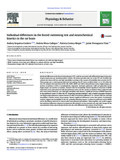Mostrar el registro sencillo del ítem
Individual differences in the forced swimming test and neurochemical kinetics in the rat brain
| dc.creator | Sequeira Cordero, Andrey | |
| dc.creator | Mora Gallegos, Andrea | |
| dc.creator | Cuenca Berger, Patricia | |
| dc.creator | Fornaguera Trías, Jaime | |
| dc.date.accessioned | 2014-12-16T21:23:00Z | |
| dc.date.available | 2014-12-16T21:23:00Z | |
| dc.date.issued | 2014-02-08 | |
| dc.identifier.issn | 0031-9384 | |
| dc.identifier.other | essn:1873-507X | |
| dc.identifier.uri | https://hdl.handle.net/10669/11253 | |
| dc.description | artículo -- Universidad de Costa Rica, Instituto de Investigaciones en Salud y Centro de Investigación en Neurociencias. 2014. Este documento es privado debido a limitaciones de derechos de autor. | es_ES |
| dc.description.abstract | Individual differences in the forced swimming test (FST) could be associatedwith differential temporal dynamics of gene expression and neurotransmitter activity. We tested juvenile male rats in the FST and classified the animals into those with low and high immobility according to the amount of immobility time recorded in FST. These groups and a control group which did not undergo the FST were sacrificed either 1, 6 or 24 h after the test. We analyzed the expression of the CRF, CRFR1, BDNF and TrkB in the prefrontal cortex, hippocampus and nucleus accumbens as well as norepinephrine, dopamine, serotonin, glutamate, GABA and glutamine in the hippocampus and nucleus accumbens. Animals with low immobility showed significant reductions of BDNF expression across time points in both the prefrontal cortex and the nucleus accumbens when compared with non-swim control. Moreover, rats with high immobility only showed a significant decrease of BDNF expression in the prefrontal cortex 6 h after the FST. Regarding neurotransmitters, only accumbal dopamine turnover and hippocampal glutamate content showed an effect of individual differences (i.e. animals with low and high immobility), whereas nearly all parameters showed significant differences across time points. Correlational analyses suggest that immobility in the FST, probably reflecting despair, is related to prefrontal cortical BDNF and to the kinetics observed in several other neurochemical parameters. Taken together, our results suggest that individual differences observed in depression-like behavior can be associated not only with changes in the concentrations of key neurochemical factors but also with differential time courses of such factors. | es_ES |
| dc.description.sponsorship | Universidad de Costa Rica/[742-A9-120 ]/UCR/Costa Rica | es_ES |
| dc.language.iso | en_US | es_ES |
| dc.publisher | Physiology & Behavior 126(1):60-69 | es_ES |
| dc.subject | BDNF expression | es_ES |
| dc.subject | Brain | es_ES |
| dc.subject | Neurotransmitters | es_ES |
| dc.subject | Genética | es_ES |
| dc.title | Individual differences in the forced swimming test and neurochemical kinetics in the rat brain | es_ES |
| dc.type | artículo original | |
| dc.identifier.doi | 10.1016/j.physbeh.2014.01.037 | |
| dc.description.procedence | UCR::Vicerrectoría de Investigación::Unidades de Investigación::Ciencias de la Salud::Instituto de Investigaciones en Salud (INISA) | es_ES |
| dc.description.procedence | UCR::Vicerrectoría de Investigación::Unidades de Investigación::Ciencias de la Salud::Centro de Investigación en Neurociencias (CIN) | |
| dc.identifier.codproyecto | 742-A9-120 |


